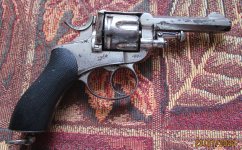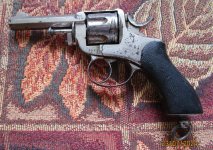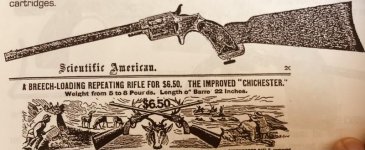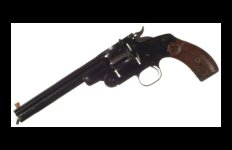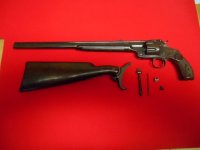Never owned or shot one, but a neat gun. What exactly was it designed to do?
You are using an out of date browser. It may not display this or other websites correctly.
You should upgrade or use an alternative browser.
You should upgrade or use an alternative browser.
320 Rev.
- Thread starter gmborkovic
- Start date
This Belgium .320 revolver belongs to a friend who handed it off to me to see if I could get it working. The hammer would not even come back. It's in working condition now but the very weak .320 Webley ammo is fairly hard to find. A head shot across the poker table might do some good, but I doubt it. I think it's a turn of the century feel good gun. The lanyard ring on the butt indicates it might have been for a Constable. Good luck with that. My buddy has it for sale these days.
Attachments
- Joined
- Dec 1, 2022
- Messages
- 697
- Reaction score
- 1,136
Hi There,
There seems to be some confusion about the S&W 320. This was
a “Revolving Rifle” that was made in the last quarter of the 19th
Century. Basically, it was a revolver with an exceedingly long
barrel with a detachable butt stock. Being a “take down” rifle,
it was convenient for packing and travel but the blast particles
that escape from the gap between the cylinder and barrel made
it objectionable to most shooters. This made it a poor seller and
S&W stopped making it only after a few years. Because it was a
low production item, it is rare and is now a pricey collectable.
Cheers!
Webb
There seems to be some confusion about the S&W 320. This was
a “Revolving Rifle” that was made in the last quarter of the 19th
Century. Basically, it was a revolver with an exceedingly long
barrel with a detachable butt stock. Being a “take down” rifle,
it was convenient for packing and travel but the blast particles
that escape from the gap between the cylinder and barrel made
it objectionable to most shooters. This made it a poor seller and
S&W stopped making it only after a few years. Because it was a
low production item, it is rare and is now a pricey collectable.
Cheers!
Webb
I'm not finding much information on the .320 Revolving Rifle cartridge compared to the .320 revolver/32 Short Colt. Are these interchangeable with the .320 Revolving Rifle Cartridge?
There is much more to valuing this model than rarity. Just under 1,000 were made and not known how many survived, but auction prices are now above $10,000. There are several other S&W models out there that come nowhere near those prices. Good example is the 44 Double Action Wesson Favorite, of which 1,000 were made, which is seldom seen today. Current auction prices are in the $5,000 and up range for fine condition guns. None have approached the $10,000+ even though few go up for sale. There were two government contracts where the factory sold 1,000 each of US Army and US Navy Model 1899 revolvers and were government stamped. They have appeal to S&W and military collectors, but prices have remained between $1,000-$2,000.
The 320 RR is a true firearm oddity that has great appeal to collectors because they exist and not just because they are rare. They are about the best conversation starter revolver in the world!
The 320 RR is a true firearm oddity that has great appeal to collectors because they exist and not just because they are rare. They are about the best conversation starter revolver in the world!
OP
thanks Webb. But when they designed it and started to make them, the
marketing people had to have a focus on a group of shooters that they were going for. Who was that market?
marketing people had to have a focus on a group of shooters that they were going for. Who was that market?
32 Revolver vs 32 Rifle
There is no comparison between the 32 S&W revolver cartridge or the 320 revolver (European designation) and the 320 Revolving Rifle cartridge. One is a revolver and the other is a rifle.
The best comparison being specific to the 320 RR would be the 32 Winchester rifle cartridge.
In fact that cartridge is what I am using to fabricate a round for the S & W RR shooting test. Approximately 1200-1300FPS with a lead bullet between 92-110 grains. ( I have seen multiple listings in my catalog collection) Original powder was black powder likely a duplex load totally between 17-21 grains depending upon cartridge manufacturer.
Both the 32 Winchester and 32 RR were designed for small game hunting and target shooting. The RR came originally with factory hunting sights and optional Peep and Globe sights. Peep and Globe sights are specifically designed for long range shooting.
So they weren’t there for looks. The RR was a long range, light weight, break down rifle. Very unique design and an extremely capable hunter in the right hands.
Murph
There is no comparison between the 32 S&W revolver cartridge or the 320 revolver (European designation) and the 320 Revolving Rifle cartridge. One is a revolver and the other is a rifle.
The best comparison being specific to the 320 RR would be the 32 Winchester rifle cartridge.
In fact that cartridge is what I am using to fabricate a round for the S & W RR shooting test. Approximately 1200-1300FPS with a lead bullet between 92-110 grains. ( I have seen multiple listings in my catalog collection) Original powder was black powder likely a duplex load totally between 17-21 grains depending upon cartridge manufacturer.
Both the 32 Winchester and 32 RR were designed for small game hunting and target shooting. The RR came originally with factory hunting sights and optional Peep and Globe sights. Peep and Globe sights are specifically designed for long range shooting.
So they weren’t there for looks. The RR was a long range, light weight, break down rifle. Very unique design and an extremely capable hunter in the right hands.
Murph
Marketing
When the RR was introduced there was already established a market for pocket rifles. These were basically long barrel revolvers with attachable shoulder stocks. They came in 22rf,32rf & cf, and 38 rf & cf. They had limited success and are clearly seen advertised in Distributor catalogs beginning in 1873.
They also made a lot of sense because they were light weight and could be shot with or without the shoulder stock.
They also lasted into the bicycle era for the exact same reason. Light weight, very easy to carry. They are formidable too since they could shoot faster than most rifles and at ranges up to 100 yards or more just as accurate. Even faster than a lever action Winchester. Just pulling a hammer back vs working a loading lever. So they were very fast and accurate shooters.
Let’s plug in the auto eject and a speed loader and “ Oh Boy”
Speed loaders were introduced in 1879. Same year as the revolving rifle.
Murph
thanks Webb. But when they designed it and started to make them, the
marketing people had to have a focus on a group of shooters that they were going for. Who was that market?
When the RR was introduced there was already established a market for pocket rifles. These were basically long barrel revolvers with attachable shoulder stocks. They came in 22rf,32rf & cf, and 38 rf & cf. They had limited success and are clearly seen advertised in Distributor catalogs beginning in 1873.
They also made a lot of sense because they were light weight and could be shot with or without the shoulder stock.
They also lasted into the bicycle era for the exact same reason. Light weight, very easy to carry. They are formidable too since they could shoot faster than most rifles and at ranges up to 100 yards or more just as accurate. Even faster than a lever action Winchester. Just pulling a hammer back vs working a loading lever. So they were very fast and accurate shooters.
Let’s plug in the auto eject and a speed loader and “ Oh Boy”
Speed loaders were introduced in 1879. Same year as the revolving rifle.
Murph
Last edited:
OP
Well,I guess if I ever shoot one, I will wear long sleeves and a glove on my left hand.
History
Colt Manufactured;
Revolving Rifles/Muskets/Carbines
Muskets: 9300
Carbines: 4400
Half Stock: 2500
Shotguns: 1,100
A very serious competitor to the S&W RR was:
CHICHESTER RIFLE COMPANY, NEW JERSEY
THEY MANUFACTURED MANY THOUSANDS OF REVOLVING RIFLES or long barrel pistols with detachable stocks and were much cheaper than the $25 S&W RR.
See photos of early 1870’s and later 1879-1889 production.
All the opinions out there about why so few S&W RRs were manufactured in my opinion it was simply competition and extremely competitive pricing.
The second photo of the Hopkins & Allen improved model came out exactly when the S&W RR was produced. 1879! I have seen several of these but no surviving stocks. Most often the barrels are cut down also so very rare example intact. These were available to chamber the 38 Long rf & cf. at a very competitive price!
Murph
Colt Manufactured;
Revolving Rifles/Muskets/Carbines
Muskets: 9300
Carbines: 4400
Half Stock: 2500
Shotguns: 1,100
A very serious competitor to the S&W RR was:
CHICHESTER RIFLE COMPANY, NEW JERSEY
THEY MANUFACTURED MANY THOUSANDS OF REVOLVING RIFLES or long barrel pistols with detachable stocks and were much cheaper than the $25 S&W RR.
See photos of early 1870’s and later 1879-1889 production.
All the opinions out there about why so few S&W RRs were manufactured in my opinion it was simply competition and extremely competitive pricing.
The second photo of the Hopkins & Allen improved model came out exactly when the S&W RR was produced. 1879! I have seen several of these but no surviving stocks. Most often the barrels are cut down also so very rare example intact. These were available to chamber the 38 Long rf & cf. at a very competitive price!
Murph
Attachments
Last edited:
- Joined
- Dec 1, 2022
- Messages
- 697
- Reaction score
- 1,136
Hi There,
It is my opinion that S&W sometimes came out with a competing
product too late to take advantage of the market demand for said
product. Case in point was their "Frontier" model of the NM#3.
Colt brought out their "Frontier Six Shooter" in 1877 but S&W
didn't respond with their own version for about ten years. This
allowed Colt to firmly establish themselves in this market and to
become the de-facto source for such arms. Plus, the SAA's rep-
utation for ruggedness didn't hurt either.
Cheers!
Webb
It is my opinion that S&W sometimes came out with a competing
product too late to take advantage of the market demand for said
product. Case in point was their "Frontier" model of the NM#3.
Colt brought out their "Frontier Six Shooter" in 1877 but S&W
didn't respond with their own version for about ten years. This
allowed Colt to firmly establish themselves in this market and to
become the de-facto source for such arms. Plus, the SAA's rep-
utation for ruggedness didn't hurt either.
Cheers!
Webb
frontier six shooter
Hi There,
It is my opinion that S&W sometimes came out with a competing
product too late to take advantage of the market demand for said
product. Case in point was their "Frontier" model of the NM#3.
Colt brought out their "Frontier Six Shooter" in 1877 but S&W
didn't respond with their own version for about ten years. This
allowed Colt to firmly establish themselves in this market and to
become the de-facto source for such arms. Plus, the SAA's rep-
utation for ruggedness didn't hurt either
True, that.
The S&W NM3 44 Winchester is of course much more uncommon than the Colts as is the 38 Winchester.
I happened on a 38 Winchester about 20 years ago and just yesterday the UPS guy delivered a NM3 44 Winchester.
I have a bent for 44-40 in most any antique gun.
I will get some pics and post them
- Joined
- Dec 1, 2022
- Messages
- 697
- Reaction score
- 1,136
Hi There,
"I happened on a 38 Winchester about 20 years ago and just yesterday the UPS guy delivered a NM3 44 Winchester.
I have a bent for 44-40 in most any antique gun.
I will get some pics and post them"
Cool! I will look forward to them.
Cheers!
Webb
"I happened on a 38 Winchester about 20 years ago and just yesterday the UPS guy delivered a NM3 44 Winchester.
I have a bent for 44-40 in most any antique gun.
I will get some pics and post them"
Cool! I will look forward to them.
Cheers!
Webb
OP
So, it was a game getter.
OP
New theory from a club historian, Joe Wesson came up with the idea and
sold the idea to dad, as a buggy gun. Ole DB loved his buggy rides around town. Sounds plausible.
sold the idea to dad, as a buggy gun. Ole DB loved his buggy rides around town. Sounds plausible.
New theory from a club historian, Joe Wesson came up with the idea and
sold the idea to dad, as a buggy gun. Ole DB loved his buggy rides around town. Sounds plausible.
Where did you read that?
OP
Read it in an e-mail from an old gun buddy. Just an educated opinion.
He did not indicate a source. Maybe he had heard it from an old Wesson family member.
He did not indicate a source. Maybe he had heard it from an old Wesson family member.

